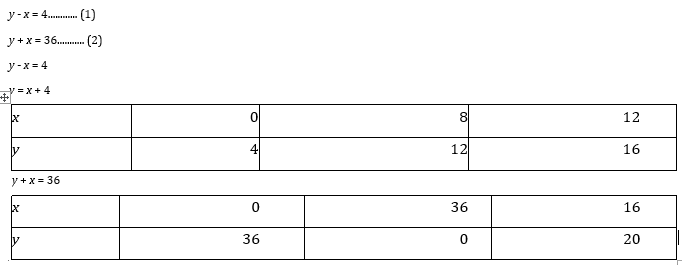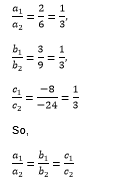Physical Address
304 North Cardinal St.
Dorchester Center, MA 02124
1. Form the pair of linear equations in the following problems, and find their solutions graphically.
(i) 10 students of class X took part in a mathematics quiz. If the number of girls is 4 more than the number of boys, find the number of boys and girls who took part in the quiz.
(ii) 5 pencils and 7 pens together cost Rs 50, whereas 7 pencils and 5 pens together cost Rs. 46. Find the cost of one pencil and that of one pen.
Answer:
(i) Let number of boys = x
Let number of girls = y
According to given conditions, we have
x + y = 10
And, x = 10 – y
putting y=0,5,10,we get,
X=10-0=10
X=10-5=5,
X=10-10=0
| x | 10 | 5 | 0 |
| y | 0 | 5 | 10 |
Number of girls is 4 more than number of boys ……..Given,
so,
Y=x+4
putting x=-4,0,4 we get,
Y=-4+4=0
Y=0+4
Y=4+4=8
| x | -4 | 0 | 4 |
| y | 0 | 4 | 8 |

We plot the points for both of the equations to find the solution.
(ii)
Let the cost of one pencil=Rs.X
and Let the cost of one pen=Rs.Y
According to the given conditions, we have:
=5x + 7y = 50
=5x=50-7y
=x=10-7/5y
Three solutions of this equation can be written in a table as follows:
| x | 3 | -4 | -11 |
| y | 5 | 10 | 15 |

Three solutions of this equation can be written in a table as follows:
| x | 0 | 2 | 4 |
| y | 9.2 | 6.4 | 3.6 |
The graphical representation is as follows:
2. On comparing the ratios a1/a2,b1/b2 and c1/c2 , find out whether the lines representing the following pairs of linear equations intersect at a point, are parallel or coincident:
(i) 5x − 4y + 8 = 0
(ii)9x + 3y + 12 = 0
7x + 6y – 9 = 018x + 6y + 24 = 0
(iii) 6x − 3y + 10 = 0
2x – y + 9 = 0
Answer:
(i) 5x − 4y + 8 = 0, 7x + 6y – 9 = 0
Comparing equation 5x − 4y + 8 = 0 with a1x + b1y + c1 = 0and 7x + 6y – 9 = 0 with a2x + b2y + c2 = 0,
We get,
Hence,
we find that,
(ii) 9x + 3y + 12 = 0, 18x + 6y + 24 = 0
Comparing equation 9x + 3y + 12 = 0 with a1x + b1y + c1 = 0and 7x + 6y – 9 = 0 with a2x + b2y + c2 = 0,
We get,
Hence
We find that,
Hence, lines are coincident.
(iii) 6x − 3y + 10 = 0, 2x – y + 9 = 0
Comparing equation 6x − 3y + 10 = 0 with a1x + b1y + c1 = 0and 7x + 6y – 9 = 0 with a2x + b2y + c2 = 0,
We get, 
Hence
We find that,
Hence,
lines are parallel to each other.
3. On comparing the ratios a1/a2,b1/b2 and c1/c2 , find out whether the following pair of linear equations are consistent, or inconsistent.
(i) 3x + 2y = 5, 2x − 3y = 8
(ii) 2x − 3y = 7, 4x − 6y = 9
(iii) 3x/2 + 5y/3 = 7, 9x − 10y = 14
(iv) 5x − 3y = 11, −10x + 6y = −22
Answer:
(i) 3x + 2y = 5, 2x − 3y = 7
Comparing equation 3x + 2y = 5 with a1x + b1y + c1 = 0and 7x + 6y – 9 = 0 with a2x + b2y + c2 = 0,
We get,

Hence,
Therefore,these linear equations will intersect at one point only and have only one possible solution.
And,pair of linear euations is consistent
(ii) 2x − 3y = 8, 4x − 6y = 9
Comparing equation 2x − 3y = 8 with a1x + b1y + c1 = 0and 7x + 6y – 9 = 0 with a2x + b2y + c2 = 0,
We get,
Hence,
Therefore,these linear equations are parallel to each other and have no possible solution.in
And,pair of linear euations is inconsistent
(iii)  9x − 10y = 14
9x − 10y = 14
We get,
Hence,
Therefore, these linear equations will intersect each other at one point and have only one possible solution.
And,pair of linear euations is consistent
(iv) 5x − 3y = 11, −10x + 6y = −22
Comparing equation 5x − 3y = 11 with a1x + b1y + c1 = 0and 7x + 6y – 9 = 0 with a2x + b2y + c2 = 0,
We get,
Hence,
Therefore these pair of lines have infinite number of solutions
And,pair of linear euations is consistent
4. (i) x + y = 5, 2x + 2y = 10
(ii) x – y = 8, 3x − 3y = 16
(iii) 2x + y = 6, 4x − 2y = 4
(iv) 2x − 2y – 2 = 0, 4x − 4y – 5 = 0
Answer:
(i) x + y = 5, 2x + 2y = 10
We get,
Hence,
(ii) x – y = 8, 3x − 3y = 16
We get,
Hence,
Therefore, these linear equations are intersecting each other at one point and thus have only one possible solution.
Hence,the pair of linear equations is inconsistent.
(iii) 2x + y = 6, 4x − 2y = 4
We get,
Hence,
Therefore, these linear equations are intersecting each other at one point and thus have only one possible solution.
Hence,the pair of linear equations is consistent

(iv) 2x − 2y – 2 = 0, 4x − 4y – 5 = 0
We get,
Hence,
Therefore, these linear equations are parallel to each other and have no possible solution,
Hence,the pair of linear equations is inconsistent.
5. Half the perimeter of a rectangle garden, whose length is 4 m more than its width, is 36 m. Find the dimensions of the garden.
Answer:
Let width of rectangular garden = x metres
and length=y
So,
Hence, the graphic representation is as follows.
6. Given the linear equation (2x + 3y – 8 = 0), write another linear equation in two variables such that the geometrical representation of the pair so formed is:
(i) Intersecting lines
(ii) Parallel lines
(iii) Coincident lines
Answer:
(i) Let the second line be equal to a2x + b2y + c2 = 0,
Intersecting Lines:For this Condition,
The Second line such that it is intersecting the given line is
2x+4y-6=0
As,
(ii) Let the second line be equal to a2x + b2y + c2 = 0,
parallel Lines:
For this Condition,
Hence,the second line can be 4x+6y-8=0
As,
(iii) Let the second line be equal to a2x + b2y + c2 = 0,
Coincident lines: For coincident lines,
Hence,the second line can be 6x+9y-24=0
As,
7. Draw the graphs of the equations x – y + 1 = 0 and 3x + 2y – 12 = 0. Determine the coordinates of the vertices of the triangle formed by these lines and the x-axis, and shade the triangular region.
Answer:
For equation x – y + 1 = 0, we have following points which lie on the line

For equation 3x + 2y – 12 = 0, we have following points which lie on the line


We can see from the graphs that points of intersection of the lines with the x–axis are (–1, 0), (2, 3) and (4, 0).
| CHAPTER NAME | OLD NCERT | NEW NCERT | |
| Real Numbers | EXERCISE 1.1 | ||
| EXERCISE 1.2 | 1.1 | CLICK HERE | |
| EXERCISE 1.3 | 1.2 | CLICK HERE | |
| EXERCISE 1.4 | |||
| Polynomials | EXERCISE 2.1 | 2.1 | CLICK HERE |
| EXERCISE 2.2 | 2.2 | CLICK HERE | |
| EXERCISE 2.3 | |||
| EXERCISE 2.4 | |||
| Pair of Linear Equations in Two Variables | EXERCISE 3.1 | ||
| EXERCISE 3.2 | 3.1 | CLICK HERE | |
| EXERCISE 3.3 | 3.2 | CLICK HERE | |
| EXERCISE 3.4 | 3.3 | CLICK HERE | |
| EXERCISE 3.5 | |||
| EXERCISE 3.6 | |||
| EXERCISE 3.7 | |||
| Quadratic Equations | EXERCISE 4.1 | 4.1 | CLICK HERE |
| EXERCISE 4.2 | 4.2 | CLICK HERE | |
| EXERCISE 4.3 | |||
| EXERCISE 4.4 | 4.3 | CLICK HERE | |
| Arithmetic Progressions | EXERCISE 5.1 | 5.1 | CLICK HERE |
| EXERCISE 5.2 | 5.2 | CLICK HERE | |
| EXERCISE 5.3 | 5.3 | CLICK HERE | |
| EXERCISE 5.4 | 5.4 (Optional) | CLICK HERE | |
| Triangles | EXERCISE 6.1 | 6.1 | CLICK HERE |
| EXERCISE 6.2 | 6.2 | CLICK HERE | |
| EXERCISE 6.3 | 6.3 | CLICK HERE | |
| EXERCISE 6.4 | |||
| EXERCISE 6.5 | |||
| EXERCISE 6.6 | |||
| Coordinate Geometry | EXERCISE 7.1 | 7.1 | CLICK HERE |
| EXERCISE 7.2 | 7.2 | CLICK HERE | |
| EXERCISE 7.3 | |||
| EXERCISE 7.4 | |||
| Introduction to Trigonometry | EXERCISE 8.1 | 8.1 | CLICK HERE |
| EXERCISE 8.2 | 8.2 | CLICK HERE | |
| EXERCISE 8.3 | |||
| EXERCISE 8.4 | 8.3 | CLICK HERE | |
| Some Applications of Trigonometry | EXERCISE 9.1 | 9.1 | CLICK HERE |
| Circles | EXERCISE 10.1 | 10.1 | CLICK HERE |
| EXERCISE 10.2 | 10.2 | CLICK HERE | |
| Construction | |||
| Areas Related to Circles | EXERCISE 12.1 | ||
| EXERCISE 12.2 | 11.1 | CLICK HERE | |
| EXERCISE 12.3 | |||
| Surface Areas and Volumes | EXERCISE 13.1 | 12.1 | CLICK HERE |
| EXERCISE 13.2 | 12.2 | CLICK HERE | |
| EXERCISE 13.3 | |||
| EXERCISE 13.4 | |||
| EXERCISE 13.5 | |||
| Statistics | EXERCISE 14.1 | 13.1 | CLICK HERE |
| EXERCISE 14.2 | 13.2 | CLICK HERE | |
| EXERCISE 14.3 | 13.3 | CLICK HERE | |
| EXERCISE 14.4 | |||
| Probability | EXERCISE 15.1 | 14.1 | CLICK HERE |
| EXERCISE 15.2 |